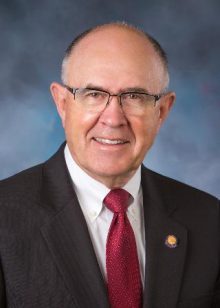During the 95-day Idaho legislative session — tied for the third-longest in the state’s history — which ended Thursday, Republican Gov. Brad Little passed multiple bills concerning Idaho education.
Little told The Argonaut as far as education goes, he accomplished what he wanted to this session.
Teacher pay, literacy funding and college scholarships were among the most significant issues addressed, he said.
In March, Little signed into law House Bill 153, which will increase starting teacher pay to $40,000 by 2021. According to Idaho News, before the passing of the bill, the minimum teacher salary for Idaho teachers was $35,800.

Little said when he visited the University of Idaho in fall of 2017, there were low numbers of students applying to the education program.

Brad Little | Courtesy
“I want to send a message to kids in high school that they want to go get their B.A. in education,” Little said.
Among K-12 school budgets, $13.1 million has been allotted to fund the expansion of Idaho’s K-3 literacy initiative. This initiative serves to increase the number of children reading proficiently by the end of third grade.
Republican Senate Majority Leader Chuck Winder said Little “fought hard” to get funding for the literacy program.
“We know that if kids are below their grade level when they leave third grade, that is going to impact them the rest of their time in grade school and junior high and high school — in fact, throughout their lives,” Winder said.
In March, Little also signed Senate Bill 1193, which includes the funding for 2,000 additional Idaho Opportunity Scholarships next year. The Idaho Press reports the Opportunity Scholarship is awarded to students based on both need and merit, with 70% weighted toward need and the other 30% toward merit.
Little said the funding of more scholarships correlates with the effort to meet the goal of 60% of Idaho’s high school students going on to receive a professional certificate or two- or four-year degree.

Chuck Winder | Courtesy
“We put a significant amount more into scholarships for mainly at need students,” Little said. “If we want to get to the 60% goal, we need to have more affordable higher education.”
Little said in the future, he thinks Idaho is going to “grey the lines” between workforce training, career technical educatiown and K-12 education.
He said it is important to think about what pathways for success there are for students who are not going to get a 2- or 4-year degree.
“UI’s mission is to create the great minds that are going to create the great ideas that those people are going to put into place,” Little said.
Going forward, Little said the goal is to consolidate overhead costs for Idaho institutions.
“So we can put more money in the front line, which is hiring the best possible faculty to teach our students,” he said.
Little said education is important so that people stay in Idaho, and said if they leave and come back to start a family, they’ll want to know there’s a good education system for their kids.
“It’s his highest priority to try to continue to improve funding for our teachers and funding for our schools,” Winder said.
Jordan Willson can be reached at [email protected]
